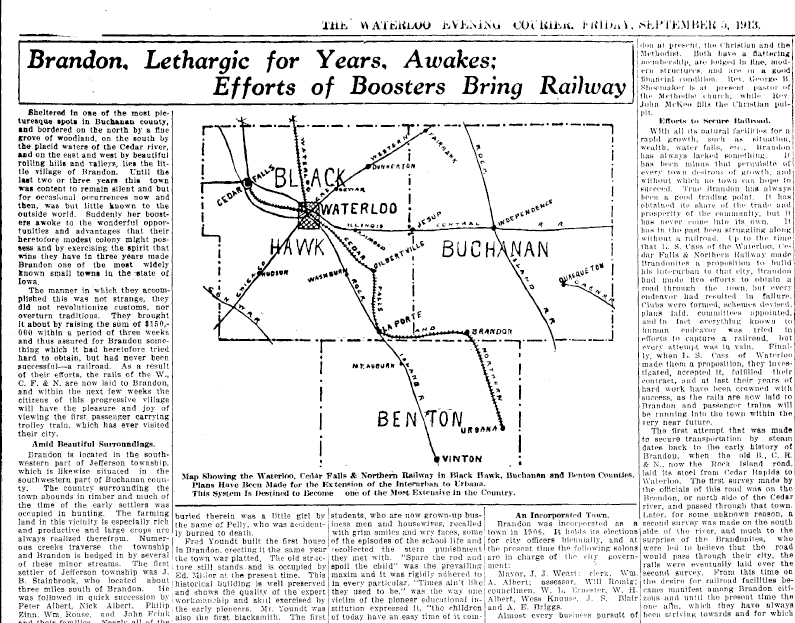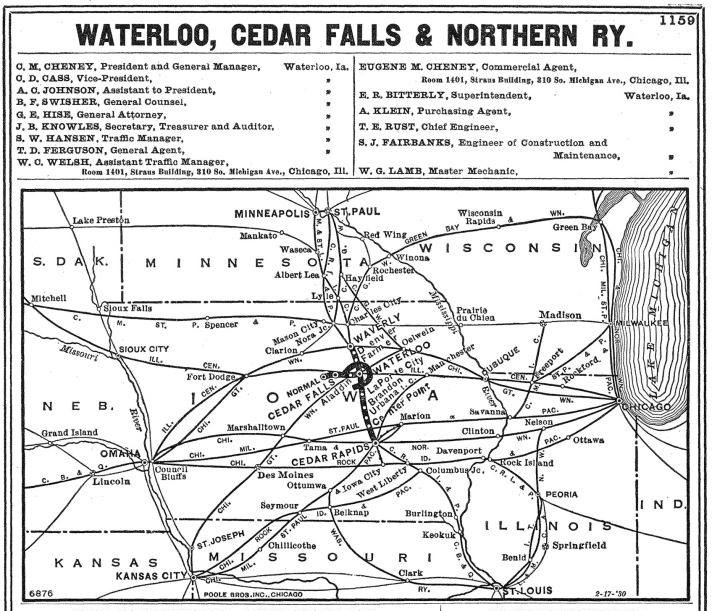Century-Old Bridge in Brandon Is a Legacy to Iowa’s Railroad Heyday

After a catastrophic 2008 flood destroyed two historic bridges that offered people on Iowa’s Cedar Valley Nature Trail passage over the Cedar River, only one functional double-arched span bridge—created on the path over a century ago—remained.
Built just east of Brandon, Iowa, in 1913 as part of an expansion of the Waterloo, Cedar Falls & Northern Railway (WCF&N), the bridge was considered an early highlight among people in the town who were thrilled to gain rail access.
“The people of Brandon are highly elated over the road and their enthusiasm holds no bounds,” reported the Waterloo Evening Courier in the Sept. 5, 1913, edition. “They are especially pleased with the elegant bridge structure, the cattle ways and culverts, all built of cement and iron, which have been installed.”
When the first train arrived in Brandon on the WCF&N Railway in August of 1913 to pick up a ceremonial load of cattle bound for Chicago, residents treated it like a jubilee.

“The entire town was out in gala attire to see the train depart,” the September 1913 Waterloo Evening Courier article continued. “Tremendous cheers (went into) the air as the little train pulled out of town, and it marked an epoch in the history of the village.”
Indeed, the arrival of the electric interurban line served as a turning point for Brandon, one that its boosters spent time and money advocating on behalf of. The Waterloo paper described the railway’s debut as an awakening in a town that was “lethargic for years.”
“Until the last two or three years this town was content to remain silent and but for occasional occurrences now and then, was but little known to the outside world,” the paper reported. “Suddenly her boosters awoke to the wonderful opportunities and advantages that their heretofore modest colony might possess and by exercising the spirit that wins they have in three years made Brandon one of the most widely known small towns in the state of Iowa.”

The modest colony’s population roughly doubled to 500 soon after the WCF&N linked it to what became one of Iowa’s largest rail systems. The WCF&N discontinued service in the mid-1950s. Illinois Central freight trains used the tracks until 1977, and then it was abandoned. Now, Brandon is connected to one of the frontrunner systems of the rail-trail movement, the Cedar Valley Nature Trail, which debuted in the early 1980s. And Brandon’s railway bridge serves as one of the few remaining architectural links to a railway system that shaped this town and others along the line.
The double-arched, cement bridge now offers people on the Cedar Valley Nature Trail a pleasant passage over Lime Creek below it. The arch architecture was something of a signature of the WCF&N’s bridges, and variations on the theme—single-, double- and three multi-arched versions—carried cargo and passengers over waterways.

Only two other original WCF&N bridges besides Brandon’s are still standing, and they are both single-arched. The double-arched span in Brandon is in shape to carry the load for the foreseeable future. Recent repairs reinforced the base of the piers with new concrete, added abutment extensions, implemented an anchoring system to support the bridge walls and more.
And now it helps bridge the vast route between Washington, D.C., and Washington State along the 3,700-mile Great American Rail-Trail®, which will ultimately allow for safe, off-road passage across the entire country.
On the Cedar Valley Nature Trail, it offers both a path forward and a look back.

Authored by Cory Matteson, with contributions by Amy Kapp
This article was developed as part of Rails to Trails Conservancy’s Great American Rail-Trail® historical marker program—launched in partnership with the William G. Pomeroy Foundation to lift hidden histories and points of local pride along the 3,700-mile developing route connecting Washington State and Washington, D.C.
A trailside marker, created through a collaboration by Black Hawk County Conservation, the Cedar Valley Nature Trail, Rails to Trails Conservancy and the William G. Pomeroy Foundation, now commemorates the bridge.
Marker Location: Near Finley Ave. and 330th St. in Brandon, IA
BRANDON BRIDGE
BUILT IN 1913, ONLY SURVIVING
DOUBLE ARCH BRIDGE ON
WATERLOO, CEDAR FALLS &
NORTHERN RAILWAY, CITY’S
FIRST INTERURBAN LINE.
CEDAR VALLEY NATURE TRAIL
WILLIAM G. POMEROY FOUNDATION 2023
Acknowledgments:
- Black Hawk County Conservation (Iowa)
- Cedar Valley Nature Trail (Black Hawk County)
- Tallgrass Historians L.C.


Donate
Everyone deserves access to safe ways to walk, bike, and be active outdoors.